No, we aren’t talking about The Blob, or The Mist or even The Thing. We’re talking about “The Thing” that keeps visitors from taking action on your site and converting. Brian has a great post on Search Engine Land talking about The Thing and how do deal with it.
, what can you do to combat that concern and give your visitors the confidence to take action.
Brian walks you through each area and what changes you can make to reduce visitor concern. Think of it as your tools to fight The Thing.
There is an insidious voice speaking to your visitors from the moment they click through to your site. It camps in the back of their minds, setting up a tent and proceeding to talk your visitors out of taking action. While there are many angles this voice can work to fill visitors with doubt, there is likely one that is common to a large number of your visitors.
It’s “the thing.”
If you can discover and address the thing — the major concern shared by a significant number of your visitors — then you can make some major improvements in your conversion rates and revenue per click.
When testing, we have found that this thing will fall into one of five areas: risk reversal, value proposition/messaging, social proof, user interface/user experience, and credibility/authority. All of these nagging questions may be present to some degree, but one of them is more pressing than the others — and addressing it will give you wins early and often.
I recommend that you open a spreadsheet so you can capture the hypotheses that come to mind as you read these gems. Your hypotheses should read like this:
“If I [change something] then more visitors will [do something good or stop doing something bad] as measured by [some metric like revenue per visit or conversion rate].”
Let’s get started.
Risk Reversal
The thought camping at the back of your visitors’ heads may be, “What if I regret this purchase?”
- What if I don’t like it?
- What if it doesn’t fit?
- What if I didn’t consider something before buying?
- What if I feel tricked?
- Will you sell my contact info to a spammer?
- What is the likelihood that you waste my time?
- Will you protect my data?
Risk reversal tests start with the return policy. The most famous return policy of late is the Zappos “return within one year and we’ll pay shipping both ways” policy. It is clearly visible throughout the site, summarized in the header.
If you’re generating leads, the most important way to communicate risk reversal is your privacy policy and privacy statement. You could test link anchor text such as “We respect your privacy,” or “Your privacy is important to us,” or “We will never share or sell your contact information.”
Did you know that free shipping falls into the category of risk reversal? It means that I won’t be surprised by high shipping rates when I get into the shopping cart. Knowing what to expect is often more important than dollars saved — after all, we know shipping is factored into the pricesomehow. Test free or flat-rate shipping.
Value Proposition & Messaging
While munching on a blackened hot dog, the voice camped at the back of your visitors’ mind is whispering, “What’s in it for me?”
- What’s my payoff?
- Will you make me look better, smarter, cooler, more interesting?
- Are you low price, high quality or good service?
- Are you making an offer I can’t refuse?
- What is the one thing I need to know about your offering?
- Why would I put my career on the line by considering your solution?
- What is your story?
- Does that girl with the headset really work for you?
Communicating your value proposition and messaging is the job of the page content — this includes text, images, video, audio and almost any other media.
Headlines and calls-to-action are always important, and testing often starts there. The inevitable hero image should be tested, especially if it is a rotating banner style so prevalent today (and so often a bad idea).
Long-form versus short copy is another way to find out what your visitors prefer.
Test more detailed pictures of your products. Test getting rid of any stock photography you have on the site.
Never underestimate the power of the words on your site. Some of the most transformational tests we’ve seen involve honing in on the right words.
Social Proof
The voice camping at the back of searchers’ mind may start a fire, roast some marshmallows and whisper, “What would others think?”
- Am I being reckless?
- Does the rest of the herd approve of you?
- Has anyone had a really bad experience with your brand?
- Has anyone had a really good experience?
- Do others confirm what you say about yourself?
- What are other businesses in my industry doing?
We are social animals, and the herd mentality never really leaves us.
Ratings and reviews are a powerful addition and should be tested if you can get your customers to chime in with their opinion.
Test testimonials near your calls-to-action and in your shopping cart.
Come up with some big numbers to describe your success. Rather than counting customers served, consider measuring your success in dollars saved, bites eaten, or seconds spent so that readers can relate to what you’ve done.
Test social media in moderation. It can be a distraction. Will your social customers post pictures of your products? Write reviews? Provide testimonials?
User Interface & User Experience
While carving a snake out of a stick with a pocket knife, the voice in the back of your visitors’ head may be saying, “Nice job. You’re lost.”
- Can I explore your offering the way I like to explore?
- I’m new here. Where do I start?
- I’m back again. Where do I go?
- What’s the next step for me?
- How many more steps do I have?
- How do I take action?
- Can I scan your site or do I have to (gasp) read?
- Where’s the discount you promised?
- What if I’m not ready to act?
- Where can I find your risk reversal, your value proposition, your social proof and evidence of your credibility?
How you present information on a page can have surprising effects on your bottom line. In general, your designer should be skilled at the use of white space, position, font, color, and proximity to guide the visitor through a page.
To start with, test making important things stand out, such as calls-to-action. Test the contrast and size of text to see if readability is an issue.
Test completely different layouts for pages to find the right ballpark to do more detailed tests. Simplify or complexify.
Never underestimate the power of ugly to add more dollars to your bottom line. Don’t get attached to your creative. Your opinion doesn’t matter.
Credibility & Authority
The voice at the back of your visitors’ head may be whispering, “Will I get duped?”
- Will I look stupid?
- Will the product be high-quality?
- Have I had a positive experience with you in the past?
- Would a reasonable person buy from you?
- Would a genius buy from you?
- Will you keep your promises to me?
- Are you good people?
- Do you care?
- Will you get me fired if I recommend you?
The first way to communicate credibility and authority is with your company logo. In general putting it in the upper left on your site does the trick. However, it may actually hurt you on targeted landing pages.
Borrowing authority is a favored strategy. Test the addition of client logos to key pages (landing pages, home page, etc.). If you take credit cards online, be sure to include Visa, MasterCard, Amex, and others, even if you take everything.
Test logos for associations you belong to. Test adding shields for certifications you’ve earned. Test the placement of site security logos, such as McAfee secure and VeriSign. Should they be at the bottom? In the header? Near the call to action button?
Test moving blog post titles to the home page to show your thought leadership (but don’t let them get stuck on your blog).
Picking A Direction For Your Testing
Hopefully, you’ve been jotting down hypotheses about your site as you’ve read this article. Now, you need to prioritize them.
Chris Goward offers PIE as prioritization criteria in his new book. Bryan Eisenberg uses a 5x5x5 model.
At Conversion Sciences, we use a Proof/Impact/Effort/Traffic model that doesn’t seem to spell anything clever. Please offer suggestions in the comments.
Those hypotheses that are supported by analytics, are expected to have a high impact, and require the least effort will bubble to the top of the list.
Now, pick one hypothesis from the top of the list that falls into each of our buckets: risk reversal, messaging, social proof, user experience and credibility. Test these first.
If and when one shows a significant win, you’ve got a good idea of what the voice in the back of your visitors’ mind is whispering to them. Try more hypotheses from this bucket.
Following The Rabbit All The Way Down The Hole
If a headline performs well (messaging), then test a hypothesis about copy length next. If a new layout provides a bottom-line boost (user experience), you might then test a hypothesis that says choices should be reordered.
What you’re doing is finding out what the biggest issue is for your visitors, and then diving in to see how far the rabbit hole goes.
When do you stop and look back at the others? When the wins become scarce and small. Switching to a new category can reinvigorate a testing schedule that needs some big news.
Test hypotheses from each of the five “buckets” to find the major concern of your visitors. This gives you the direction to take for early increases in conversion rate and revenue per click.

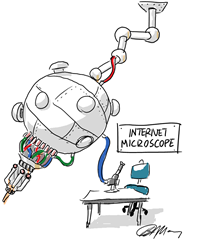
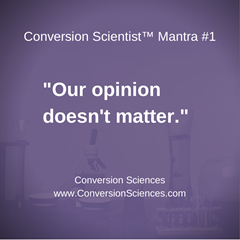
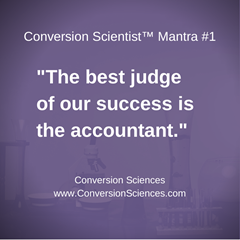
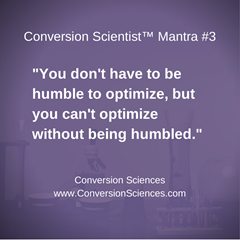

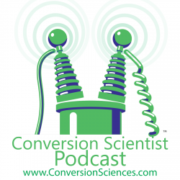
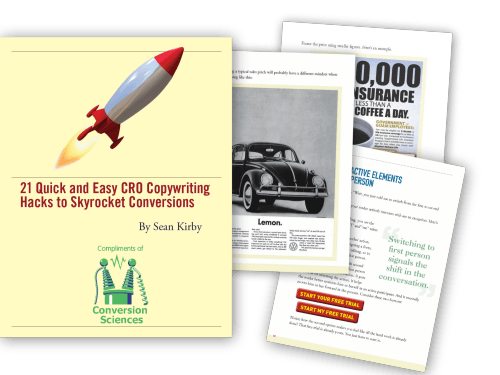
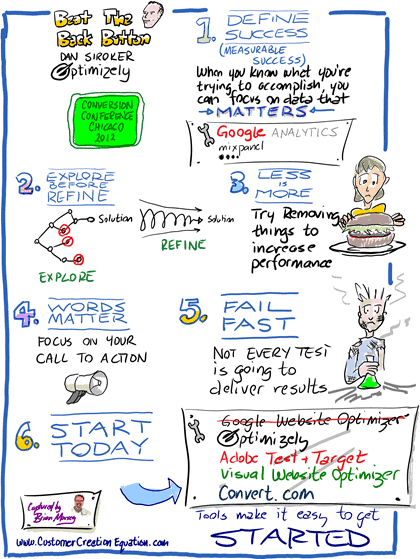
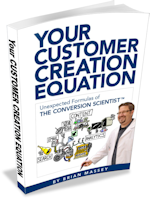
 These are the stories that caught my eye last week. If you are a curious marketer looking to learn more about conversion, please subscribe my weekly recommended reading list, For Further Study.
These are the stories that caught my eye last week. If you are a curious marketer looking to learn more about conversion, please subscribe my weekly recommended reading list, For Further Study.





